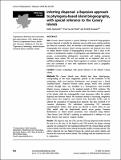Por favor, use este identificador para citar o enlazar a este item:
http://hdl.handle.net/10261/13359COMPARTIR / EXPORTAR:
 SHARE SHARE
 CORE
BASE CORE
BASE
|
|
| Visualizar otros formatos: MARC | Dublin Core | RDF | ORE | MODS | METS | DIDL | DATACITE | |

| Campo DC | Valor | Lengua/Idioma |
|---|---|---|
| dc.contributor.author | Sanmartín, Isabel | - |
| dc.contributor.author | Mark, P. van der | - |
| dc.contributor.author | Ronquist, Fredrik | - |
| dc.date.accessioned | 2009-06-01T08:28:06Z | - |
| dc.date.available | 2009-06-01T08:28:06Z | - |
| dc.date.issued | 2008-02-12 | - |
| dc.identifier.citation | Journal of Biogeography vol. 35, no3, pp. 428-449 | en_US |
| dc.identifier.issn | 0305-0270 | - |
| dc.identifier.uri | http://hdl.handle.net/10261/13359 | - |
| dc.description.abstract | Aim Oceanic islands represent a special challenge to historical biogeographers because dispersal is typically the dominant process while most existing methods are based on vicariance. Here, we describe a new Bayesian approach to island biogeography that estimates island carrying capacities and dispersal rates based on simple Markov models of biogeographical processes. This is done in the context of simultaneous analysis of phylogenetic and distributional data across groups, accommodating phylogenetic uncertainty and making parameter estimates more robust. We test our models on an empirical data set of published phylogenies of Canary Island organisms to examine overall dispersal rates and correlation of rates with explanatory factors such as geographic proximity and area size. Location Oceanic archipelagos with special reference to the Atlantic Canary Islands. Methods The Canary Islands were divided into three island-groups, corresponding to the main magmatism periods in the formation of the archipelago, while non-Canarian distributions were grouped into a fourth 'mainland-island'. Dispersal between island groups, which were assumed constant through time, was modelled as a homogeneous, time-reversible Markov process, analogous to the standard models of DNA evolution. The stationary state frequencies in these models reflect the relative carrying capacity of the islands, while the exchangeability (rate) parameters reflect the relative dispersal rates between islands. We examined models of increasing complexity: Jukes–Cantor (JC), Equal-in, and General Time Reversible (GTR), with or without the assumption of stepping-stone dispersal. The data consisted of 13 Canarian phylogenies: 954 individuals representing 393 taxonomic (morphological) entities. Each group was allowed to evolve under its own DNA model, with the island-model shared across groups. Posterior distributions on island model parameters were estimated using Markov Chain Monte Carlo (MCMC) sampling, as implemented in MrBayes 4.0, and Bayes Factors were used to compare models. Results The Equal-in step, the GTR, and the GTR step dispersal models showed the best fit to the data. In the Equal-in and GTR models, the largest carrying capacity was estimated for the mainland, followed by the central islands and the western islands, with the eastern islands having the smallest carrying capacity. The relative dispersal rate was highest between the central and eastern islands, and between the central and western islands. The exchange with the mainland was rare in comparison. Main conclusions Our results confirm those of earlier studies suggesting that inter-island dispersal within the Canary Island archipelago has been more important in explaining diversification within lineages than dispersal between the continent and the islands, despite the close proximity to North Africa. The low carrying capacity of the eastern islands, uncorrelated with their size or age, fits well with the idea of a historically depauperate biota in these islands but more sophisticated models are needed to address the possible influence of major recent extinction events. The island models explored here can easily be extended to address other problems in historical biogeography, such as dispersal among areas in continental settings or reticulate area relationships. | en_US |
| dc.description.sponsorship | I.S. has been funded by the Swedish Research Council through Grant (621-2003-021). F.R. and P.V.D.M were funded by R01 GM-069801 (NIH). I.S. and F.R. were also funded by the NSF through the NESCent 'Biogeography Working Group'. | en_US |
| dc.format.extent | 366315 bytes | - |
| dc.format.mimetype | application/pdf | - |
| dc.language.iso | eng | en_US |
| dc.publisher | Blackwell Publishing | en_US |
| dc.rights | closedAccess | en_US |
| dc.subject | Bayesian inference | en_US |
| dc.subject | Canary Islands | en_US |
| dc.subject | Carrying capacity | en_US |
| dc.subject | Dispersal rates | en_US |
| dc.subject | Island biogeography | en_US |
| dc.subject | Stochastic models | en_US |
| dc.title | Inferring dispersal: a Bayesian approach to phylogeny-based island biogeography, with special reference to the Canary Islands | en_US |
| dc.type | artículo | en_US |
| dc.identifier.doi | 10.1111/j.1365-2699.2008.01885.x | - |
| dc.description.peerreviewed | Peer reviewed | en_US |
| dc.relation.publisherversion | http://dx.doi.org/10.1111/j.1365-2699.2008.01885.x | en_US |
| dc.contributor.funder | Swedish Research Council | - |
| dc.contributor.funder | National Institutes of Health (US) | - |
| dc.contributor.funder | Länsförsäkringar Alliance | - |
| dc.identifier.funder | http://dx.doi.org/10.13039/100000002 | es_ES |
| dc.type.coar | http://purl.org/coar/resource_type/c_6501 | es_ES |
| item.openairecristype | http://purl.org/coar/resource_type/c_18cf | - |
| item.fulltext | With Fulltext | - |
| item.cerifentitytype | Publications | - |
| item.openairetype | artículo | - |
| item.languageiso639-1 | en | - |
| item.grantfulltext | open | - |
| Aparece en las colecciones: | (RJB) Artículos | |
Ficheros en este ítem:
| Fichero | Descripción | Tamaño | Formato | |
|---|---|---|---|---|
| Inferring dispersal.pdf | 458,56 kB | Adobe PDF |  Visualizar/Abrir |
CORE Recommender
SCOPUSTM
Citations
190
checked on 12-abr-2024
WEB OF SCIENCETM
Citations
188
checked on 21-feb-2024
Page view(s)
372
checked on 18-abr-2024
Download(s)
361
checked on 18-abr-2024
Google ScholarTM
Check
Altmetric
Altmetric
NOTA: Los ítems de Digital.CSIC están protegidos por copyright, con todos los derechos reservados, a menos que se indique lo contrario.
